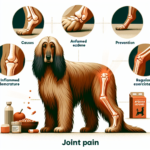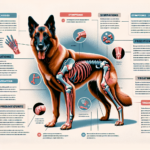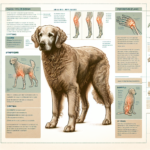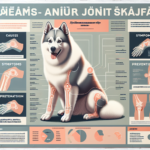Great Dane Joint Pain: Causes, Symptoms, Prevention, and Treatment
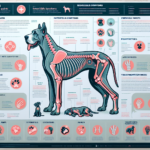
Introduction
The Great Dane, often referred to as the “Apollo of dogs,” is a breed known for its majestic stature and gentle demeanor. Originating from Germany, Great Danes were initially bred for hunting wild boar, a task that required both strength and agility. Over time, they have evolved into beloved family pets, known for their loyalty, affectionate nature, and imposing size. Despite their gentle giant reputation, Great Danes are prone to several health issues, with joint pain being a significant concern.
Joint health is particularly crucial for Great Danes due to their large size and rapid growth rate. These factors can place immense stress on their joints, making them susceptible to various joint-related issues. Understanding the causes, symptoms, prevention, and treatment of joint pain in Great Danes is essential for ensuring their well-being and quality of life.
Breed-Specific Joint Pain Risks
Genetic Predisposition
Great Danes have a genetic predisposition to several joint-related issues, including hip dysplasia, arthritis, and elbow dysplasia. Hip dysplasia is a condition where the hip joint does not fit into the hip socket properly, leading to pain and mobility issues. Similarly, elbow dysplasia involves abnormal development of the elbow joint, causing discomfort and lameness. Arthritis, a degenerative joint disease, is also common in Great Danes, particularly as they age.
Age-Related Risks
As Great Danes age, the risk of joint pain increases. The breed’s rapid growth during puppyhood can lead to developmental issues that manifest later in life. Typically, joint problems may start to appear as early as 5-6 years of age, although some dogs may experience issues sooner. Regular veterinary check-ups are crucial for early detection and management of age-related joint pain.
Activity Level and Joint Stress
Great Danes are generally active dogs that enjoy playtime and exercise. However, their large size means that even moderate activity can place significant stress on their joints. Activities that involve jumping or sudden movements can exacerbate joint issues. Owners should be mindful of their dog’s activity level and avoid high-impact exercises that could strain their joints.
Common Symptoms of Joint Pain in Great Danes
General Symptoms
- Limping or favoring one leg
- Stiffness, especially after rest
- Reluctance to move or climb stairs
- Decreased activity or playfulness
- Visible discomfort or pain when touched
Breed-Specific Symptoms
In Great Danes, joint pain may also manifest as a reluctance to rise from a lying position, difficulty in maintaining a standing posture, or a noticeable change in gait. Due to their size, even minor joint issues can become more pronounced and affect their overall mobility.
When to Consult a Vet
If you notice any of the above symptoms in your Great Dane, it is essential to consult a veterinarian promptly. Early intervention can prevent the progression of joint issues and improve your dog’s quality of life. Regular veterinary check-ups are also crucial for monitoring joint health and catching any problems early.
Preventive Measures for Joint Health
Exercise Recommendations
Maintaining an appropriate exercise routine is vital for Great Danes. Low-impact activities such as walking and swimming are excellent for keeping their joints healthy without causing undue stress. Avoid high-impact exercises like jumping or running on hard surfaces. Consistent, moderate exercise helps maintain muscle strength and joint flexibility.
Dietary Suggestions
A balanced diet rich in essential nutrients is crucial for joint health. Consider incorporating foods or supplements that contain glucosamine, chondroitin, and omega-3 fatty acids, which support joint function and reduce inflammation. Consult your veterinarian for specific dietary recommendations tailored to your Great Dane’s needs.
Weight Management
Maintaining a healthy weight is critical for reducing joint stress in Great Danes. Excess weight can exacerbate joint issues and lead to additional health problems. Monitor your dog’s weight regularly and adjust their diet and exercise routine as needed to keep them at an optimal weight.
Early Screening and Monitoring
Regular veterinary check-ups and early screening for joint issues are essential for Great Danes. X-rays and other diagnostic tests can help detect joint problems early, allowing for timely intervention. Discuss with your veterinarian about the appropriate screening schedule for your dog.
Treatment Options for Joint Pain
Non-Surgical Treatments
Non-surgical treatments for joint pain in Great Danes include medications, physical therapy, and lifestyle adjustments. Anti-inflammatory drugs and pain relievers can help manage symptoms, while physical therapy can improve mobility and strengthen muscles. Lifestyle adjustments, such as providing a comfortable bed and avoiding high-impact activities, can also alleviate joint pain.
Surgical Options
In severe cases, surgical intervention may be necessary. Common surgical options for joint pain in Great Danes include hip replacement, arthroscopy, and joint fusion. These procedures can significantly improve mobility and reduce pain, but they come with risks and require a thorough discussion with your veterinarian.
Alternative Therapies
Alternative treatments such as acupuncture, hydrotherapy, and massage can also benefit Great Danes with joint pain. Acupuncture can help reduce pain and inflammation, while hydrotherapy provides low-impact exercise that strengthens muscles without stressing the joints. Massage therapy can improve circulation and alleviate muscle tension.
Lifestyle and Management Tips
Daily Care Routine
A daily care routine for a Great Dane with joint pain should include gentle exercise, a balanced diet, and regular monitoring of their condition. Provide a comfortable, supportive bed and avoid activities that could strain their joints. Regularly check for any signs of discomfort or changes in mobility.
Modifying the Home Environment
Making your home more comfortable for a Great Dane with joint pain can significantly improve their quality of life. Consider installing ramps to help them navigate stairs, providing orthopedic beds for better support, and ensuring that their living area is free of obstacles that could cause injury.
Long-Term Management
Long-term management of joint pain in Great Danes involves regular veterinary check-ups, consistent exercise, a balanced diet, and weight management. Monitoring their condition and making necessary adjustments to their care routine can help keep them active and happy despite joint pain.
FAQs About Great Danes and Joint Pain
What are the early signs of joint pain in Great Danes?
Early signs of joint pain in Great Danes include limping, stiffness, reluctance to move, and decreased activity. If you notice any of these symptoms, consult your veterinarian promptly.
Can joint pain in Great Danes be prevented?
While it may not be possible to prevent joint pain entirely, you can reduce the risk by maintaining a healthy weight, providing appropriate exercise, and ensuring a balanced diet rich in joint-supporting nutrients.
Are there specific exercises that are better for Great Danes with joint pain?
Low-impact exercises such as walking and swimming are ideal for Great Danes with joint pain. These activities help maintain muscle strength and joint flexibility without causing undue stress.
What dietary supplements can help with joint health in Great Danes?
Supplements containing glucosamine, chondroitin, and omega-3 fatty acids can support joint health in Great Danes. Consult your veterinarian for specific recommendations tailored to your dog’s needs.
When should I consider surgery for my Great Dane’s joint pain?
Surgery should be considered when non-surgical treatments are no longer effective, and your dog’s quality of life is significantly impacted. Discuss the potential risks and benefits with your veterinarian to make an informed decision.
Conclusion
Joint pain is a common concern for Great Danes, given their large size and genetic predisposition to joint issues. By understanding the causes, symptoms, prevention, and treatment options, owners can take proactive steps to ensure their dog’s joint health. Regular veterinary check-ups, appropriate exercise, a balanced diet, and weight management are crucial for preventing and managing joint pain. Early intervention and a comprehensive care routine can significantly improve the quality of life for Great Danes suffering from joint pain.
Remember, your veterinarian is your best resource for advice and guidance on maintaining your Great Dane’s joint health. By working together, you can help your gentle giant live a happy, active, and pain-free life.

